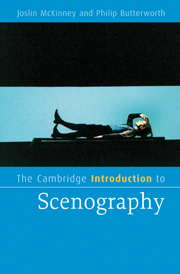Book contents
- Frontmatter
- Contents
- List of illustrations
- List of boxed quotations
- Preface
- Acknowledgements
- Part 1 Elements
- Part 2 Processes of scenography
- Part 3 Realisation and reception
- Chapter 6 Analysis of scenography
- Chapter 7 Reception of scenography
- Chapter 8 Completion and exchange of the image
- Notes
- Bibliography
- Index
- Cambridge Introductions to …
Chapter 8 - Completion and exchange of the image
Published online by Cambridge University Press: 05 February 2015
- Frontmatter
- Contents
- List of illustrations
- List of boxed quotations
- Preface
- Acknowledgements
- Part 1 Elements
- Part 2 Processes of scenography
- Part 3 Realisation and reception
- Chapter 6 Analysis of scenography
- Chapter 7 Reception of scenography
- Chapter 8 Completion and exchange of the image
- Notes
- Bibliography
- Index
- Cambridge Introductions to …
Summary
It is important not to consider experience of scenography separately from the total experience of performance. However, consideration of scenographic aspects of performance serves to highlight particular qualities and characteristics of the theatrical event. A scenographic perspective also emphasises the extent to which individual audience members determine the success and significance of performance. This concluding chapter considers what audiences might take from engagement with scenography and how the role of the audience is reshaped through scenographic practice and understanding.
Theatre images
Alan Read has claimed that images are the essence of theatre and that theatre images are ‘part of an economy of symbolic exchange’. The images he describes are not limited to the visual. The kinds of images that theatre produces are informed by space and time and by visual, auditory, and other sensory stimuli. They are not created entirely by the production itself, but come about as a result of the production being able to activate the spectator's imagination:
a woman reaching for a man, a balloon ascending, sand descending, the reverberation of a forest – like others [they] add up to more than the sum of their parts, they have physical depth and imaginative height. They are not solely literary, visual, or poetic images but potentially theatre images, and as such are produced by the relationship between bodies in place, made space, and the presence of more than a seeing eye; they are regarded by a perceiving audience.
- Type
- Chapter
- Information
- The Cambridge Introduction to Scenography , pp. 189 - 197Publisher: Cambridge University PressPrint publication year: 2009

